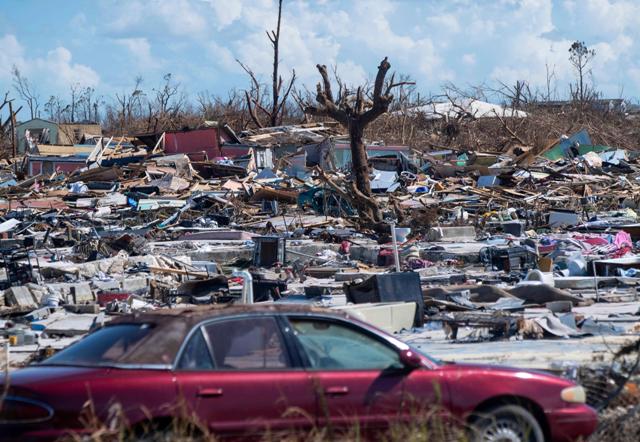 Septemeber 2019: Marsh Harbor, Abaco Island. Damage from Hurricane Dorian in the Bahamas. [Credit: Robin Loznak/ZUMA Wire/Alamy Live News]
Septemeber 2019: Marsh Harbor, Abaco Island. Damage from Hurricane Dorian in the Bahamas. [Credit: Robin Loznak/ZUMA Wire/Alamy Live News]
The archipelago was battered over three days in early September by one of the most powerful storms ever to hit the Caribbean. The Abaco Islands and Grand Bahama suffered catastrophic damage as Hurricane Dorian made landfall, with cars submerged and houses turned into matchwood. At least 50 people were killed by the storm, which is one of the strongest hurricanes ever recorded in the Atlantic, second only to Hurricane Allen in 1980. About 1,300 people are still unaccounted for. The prime minister, Hubert Minnis, said the death toll was likely to rise, calling Dorian ‘one of the greatest national crises in our country’s history’.
Lia Head-Rigby, who helps run a hurricane relief organisation in the Commonwealth member state, told the Associated Press: ‘It’s total devastation. It’s decimated. Apocalyptic.’ Reporting from Abaco, the Bahamas Press said: ‘The place is a disaster; no business is operable and bodies are floating around Big Cay. The concern is nobody knows how many people died, and they feel when the water subsides some bodies will be washed out to sea.’ The news website reported seeing bodies being loaded on to a lorry in Abaco and suggested ‘scores have died’.
The International Red Cross said 62,000 Bahamians – most of the population of Abaco and Grand Bahama – had been left with no access to fresh water after flooding and seawater contaminated wells. Some 13,000 homes were destroyed – nearly half of the total number on Grand Bahama and Abaco – after 185mph (360km/h) winds and gusts of up to 220mph ripped through the low-lying islands.Storm surges of 4-5 metres (12-18ft) were exacerbated by unusually high ‘king tides’.
The Bahamas’ economy is heavily dependent on tourism, which accounts for half of GDP, but the 700 islands and cays, of which 30 are inhabited, may not be welcoming visitors for years. ‘It’s not rebuilding something that was there – we have to start again,’ said Head-Rigby. Grand Bahama’s airport was under two metres of water. The storm surge, exacerbated by rainfall of up to 89cm in places, forced people to take refuge in attics. A radio station received more than 2,000 distress messages, including one of a grandmother having to cut a hole in her roof for her and her six grandchildren to escape as floodwaters lapped at the eaves and another of a five-month-old baby stranded on a roof. A video widely shared on social media by the Bahamas’ agriculture minister, Michael Pintard, showed his house half submerged with water at windows seven metres above sea level.
What made Dorian even more destructive was that the storm stalled for a day over the Bahamas, eventually edging northwards at only 1mph. It eventually dropped to a category 4 then 3 as it headed towards Florida. Researchers are not yet sure exactly why tropical storms are tending to stall more often in recent years but believe it is caused by a slowing of global wind flows, which is at least partly linked to the rapid warming of the Arctic. Jim Kossin, a hurricane expert with the National Oceanic and Atmospheric Administration, said: ‘Global warming makes the global atmospheric circulation slow down.’ As the temperature contrast between the poles and the equatorial regions drives this circulation, the more the Arctic warms the less wind there will be in the tropics, hence hurricanes stalling. In addition, warmer oceans add to the intensity and frequency of hurricanes.
The US National Weather Service said preliminary data suggested that the last time a hurricane this powerful made landfall was on Labor Day 1935, when more than 400 Americans were killed in Florida. Minnis called Dorian’s devastation ‘unprecedented’ and said: ‘We are in the midst of a historic tragedy.’ But the grim reality is that the exceptional will become all too familiar in the Caribbean as the climate crisis worsens.



